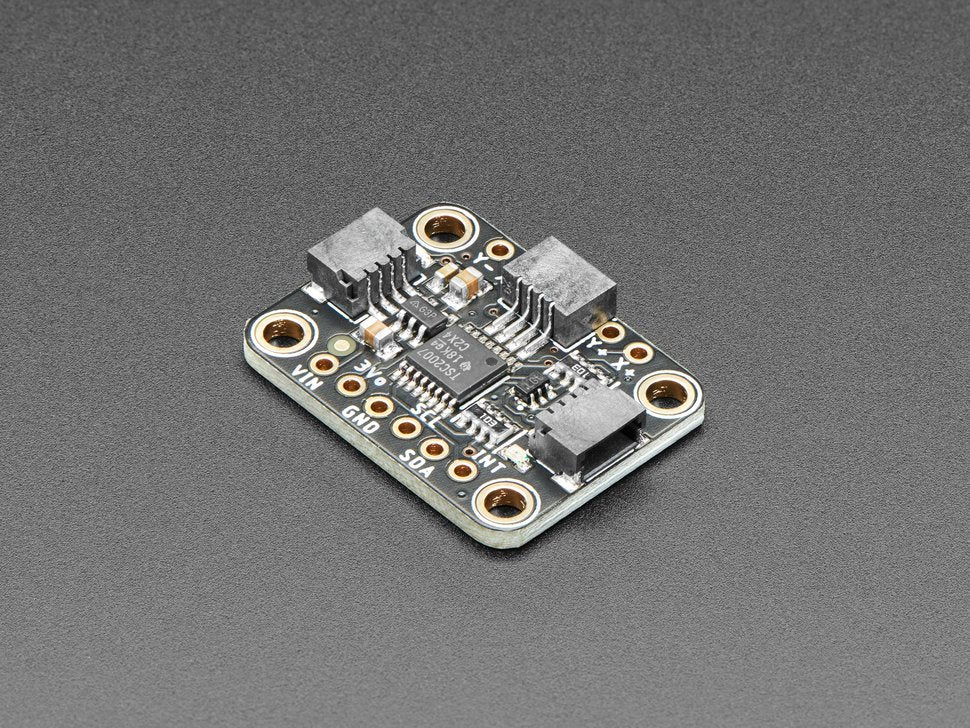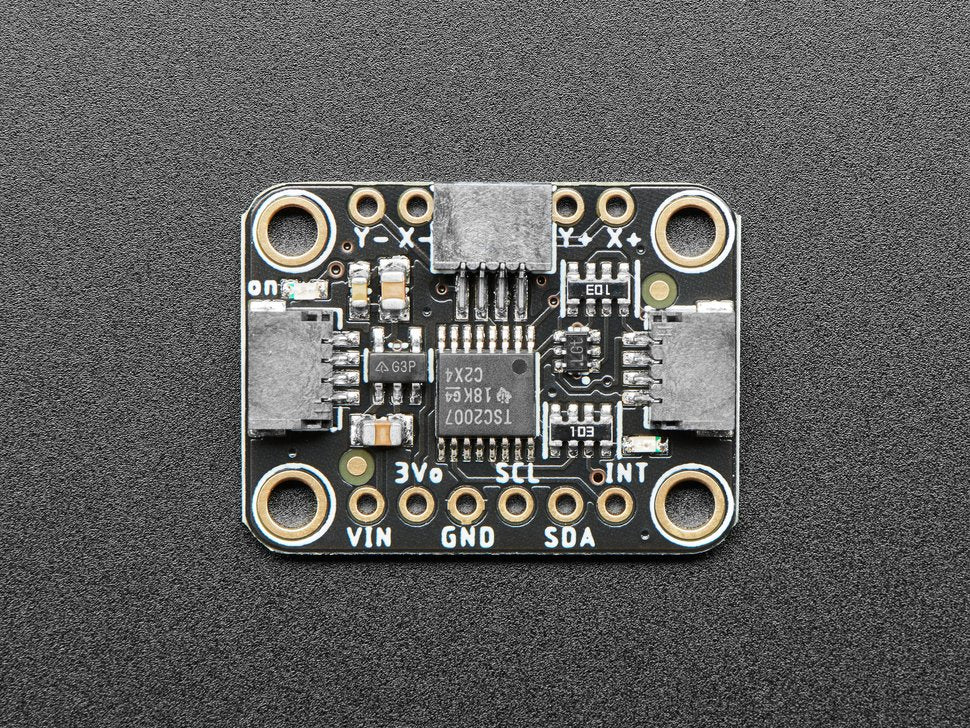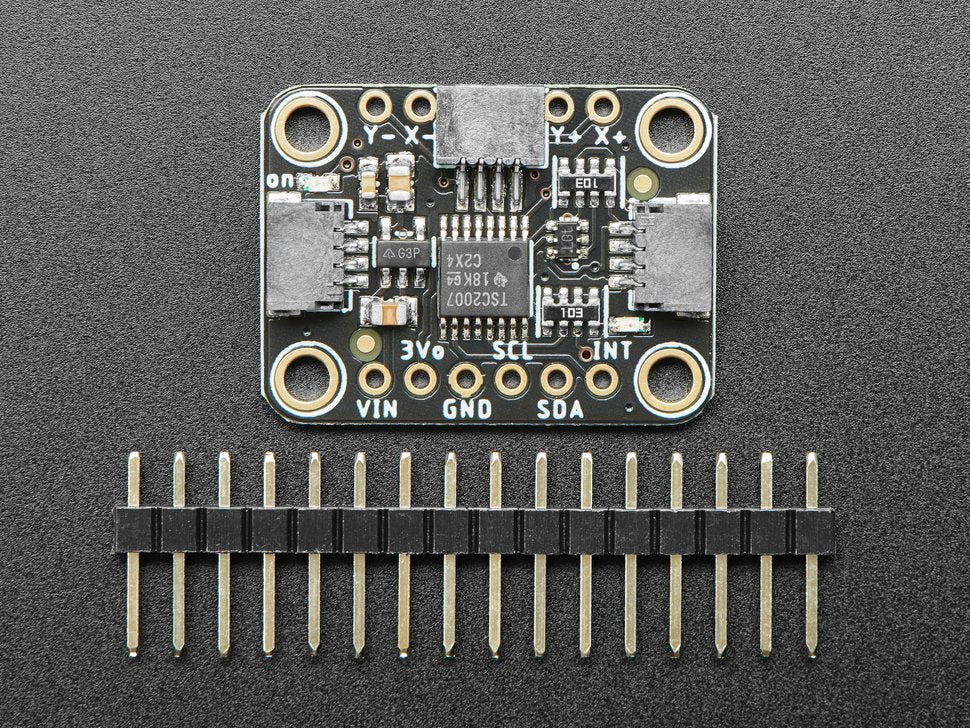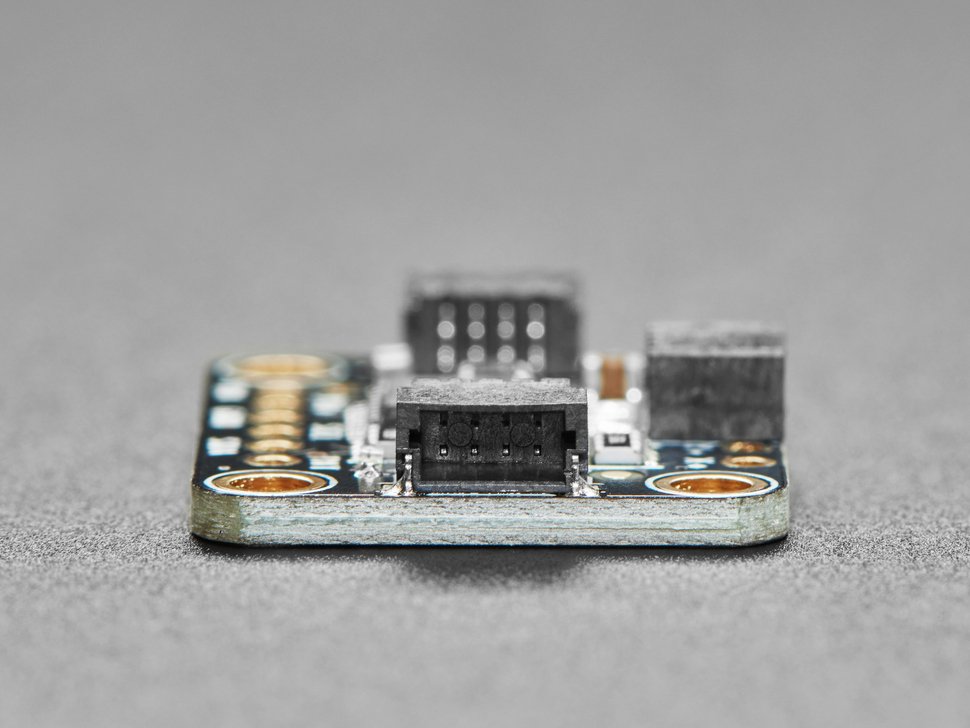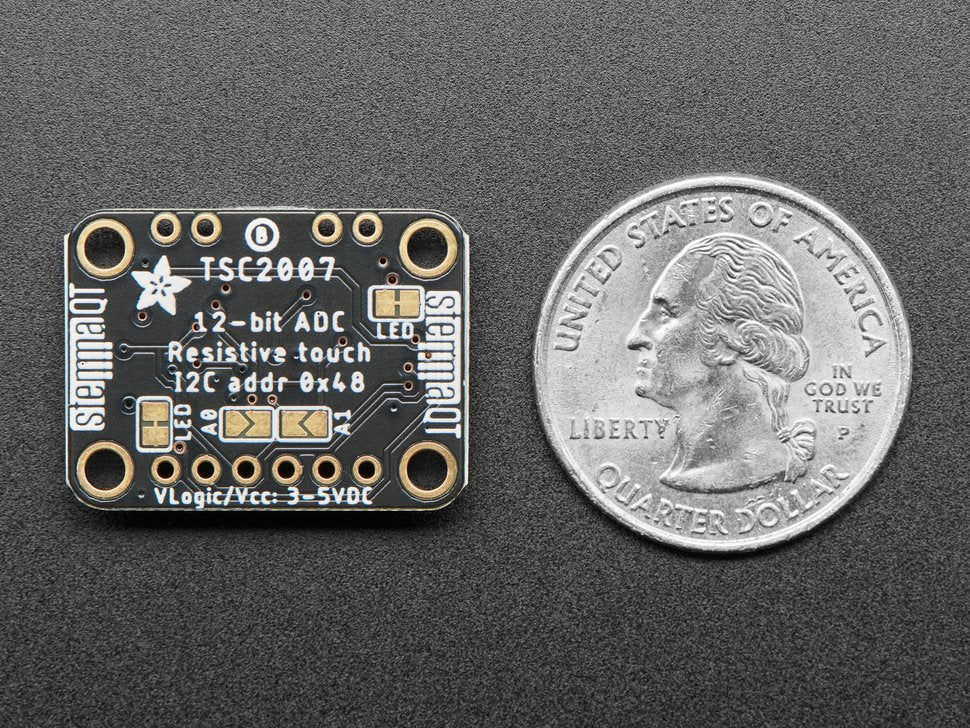Wird der Touchscreen Ihres Bildschirms zu einer Herausforderung für Sie? Resistive Touchscreens sind unglaublich beliebt als Overlays für TFT- und LCD-Displays. Das einzige Problem ist, dass sie einen Haufen analoger Pins benötigen und man sie ständig abfragen muss, da die Overlays selbst im Grunde nur große Potentiometer sind. Wenn Ihr Mikrocontroller keine analogen Eingänge hat oder Sie einfach nur einen eleganteren Controller wollen, ist der TSC2007 eine gute Möglichkeit, dieses Problem zu lösen.
Dieses Breakout-Board enthält den TSC2007, der über eine einfach zu bedienende I2C-Schnittstelle verfügt. Es gibt auch einen Interrupt-Pin, mit dem du deinem Mikrocontroller oder Mikrocomputer anzeigen kannst, wenn eine Berührung erkannt wurde. Adafruit hat den Chip mit einem 3V-Spannungsregler und Level-Shifting ausgestattet, so dass er sicher mit 3V- oder 5V-Logik verwendet werden kann. Es handelt sich um einen schön gestalteten Chip, der sehr stabile und präzise Messwerte liefert. Adafruit fand heraus, dass er auch viel schneller ist als der Versuch, alle Messwerte auf einem Arduino zu erfassen.
Für die Bildschirme, die 1mm Pitch FPC-Kabel haben, können Sie das Kabel direkt in den Stecker stecken. Die meisten mittelgroßen/großen Touchscreens haben diese Art von Steckern. Wenn Sie eine andere Art von Touchscreen haben, sind die vier X/Y-Kontakte auf 0,1" Pitch Breakouts verfügbar, so dass Sie sie von Hand löten oder verdrahten können.
Der Einstieg ist mit der einfachen TSC2007 Arduino-Bibliothek von Adafruit oder der TSC2007 CircuitPython/Python-Bibliothek für Mikrocontroller oder Raspberry Pi super einfach. Schließen Sie einen beliebigen 4-Draht-Resistiv-Touchscreen mit 1 mm Raster an den integrierten FPC-Anschluss an und verwenden Sie dann das Bibliotheksbeispiel, um Berührungspunkte mit X-, Y- und Z-Ergebnissen (Druck) sofort zu lesen. Es gibt einen IRQ-Pin, der niedrig wird, wenn eine Berührung erkannt wird. Sie können diesen benutzen, um das I2C-Polling zu reduzieren - Adafruit hat auch eine rote LED auf dieser Leitung, die bei der Fehlersuche helfen kann, da sie leuchten sollte, wenn das Panel berührt wird.
Technische Details
Verwendet die Standard I2C Adresse 0x48, zwei Adresspins ermöglichen bis zu 4 Geräte an einem I2C Bus
Produkt-Abmessungen: 25.5mm x 19.0mm x 4.6mm / 1.0" x 0.7" x 0.2"
Produktgewicht: 2.1g / 0.1oz
English Description
Getting touchy performance with your screen's touch screen? Resistive touch screens are incredibly popular as overlays to TFT and LCD displays. Only problem is they require a bunch of analog pins and you have to keep polling them since the overlays themselves are basically just big potentiometers. If your microcontroller doesn't have analog inputs, or maybe you want just a way more elegant controller, the TSC2007 is a nice way to solve that problem.
This breakout board features the TSC2007, which has an easy-to-use I2C interface available. There is also an interrupt pin that you can use to indicate when a touch has been detected to your microcontroller or microcomputer. Adafruit wrapped up the chip with a 3V voltage regulator and level shifting so it's safe to use with 3V or 5V logic. Its a nicely designed chip, and has very stable precise readings. Adafruit found its also a lot faster than trying to do all the readings on an Arduino.
For the screens that have 1mm pitch FPC cables, you can plug the cable right into the connector. The majority of medium/large touchscreens have that kind of connector. If you have another kind of touch screen, the four X/Y contacts are available on 0.1" pitch breakouts so you can hand-solder or wire them.
Getting started is super easy with Adafruit's simple TSC2007 Arduino library or TSC2007 CircuitPython/Python library for microcontrollers or Raspberry Pi. Plug any 1mm-pitch 4-wire resistive touchscreen to the on-board FPC connector, then use the library example to read touch points with X, Y and Z (pressure) results returned instantaneously. There's an IRQ pin that will drop low when a touch is detected, you can use that to reduce the I2C polling - Adafruit also have a red LED on that line which can help debugging as it should light when the panel is touched.
Technical Details
Uses default I2C address 0x48, two address pins allow up to 4 devices on one I2C bus
Product Dimensions: 25.5mm x 19.0mm x 4.6mm / 1.0" x 0.7" x 0.2"
Product Weight: 2.1g / 0.1oz
Sicherheitsangaben
- Lesen Sie die Bedienungsanleitung sorgfältig durch, bevor Sie das Produkt verwenden.
- Stellen Sie sicher, dass alle Montage- und Installationsanweisungen des Herstellers sorgfältig befolgt werden.
- Verwenden Sie das Produkt nur für den vorgesehenen Zweck.
- Die unsachgemäße Nutzung dieses Produkts kann zu schweren Verletzungen oder Sachschäden führen.
- Nicht für Kinder unter 10 Jahren geeignet.
- Bei unsachgemäßer Verwendung besteht eine Verletzungsgefahr.
- Dieses Produkt entspricht den geltenden Sicherheitsanforderungen der Europäischen Union.
- Dieses Produkt wurde gemäß der GPSR geprüft, die sicherstellt, dass alle relevanten Sicherheitsanforderungen für Konsumgüter eingehalten werden.
Nachverfolgbarkeitsinformationen
Jedes Produkt verfügt über eines oder mehrere der folgenden Merkmale:
- Ein CE-Kennzeichen, das die Einhaltung der Sicherheits-, Gesundheits- und Umweltschutzanforderungen der Europäischen Union anzeigt.
- Eine eindeutige Serien- oder Chargennummer, um die Nachverfolgbarkeit zu gewährleisten und bei Bedarf Rückrufaktionen zu unterstützen.
- Hersteller- und Importeurangaben für den Kundensupport und Sicherheitsanfragen.
Überwachung und Berichterstattung von Vorfällen
Für den unwahrscheinlichen Fall eines Produktproblems haben wir Verfahren implementiert, um:
- Kundenbeschwerden zeitnah bearbeiten.
- Schwerwiegende Vorfälle über das EU Safety Gate/RAPEX-System melden.
- Mit den Marktüberwachungsbehörden zusammenarbeiten, um die öffentliche Sicherheit zu gewährleisten.
Kontakt:
- Email: support [@] pi3g.com
- Telefon: 0341 / 392 858 40
Dieses Produkt ist vollständig mit allen geltenden EU-Vorschriften konform, um die Sicherheit unserer geschätzten Kunden zu gewährleisten.

